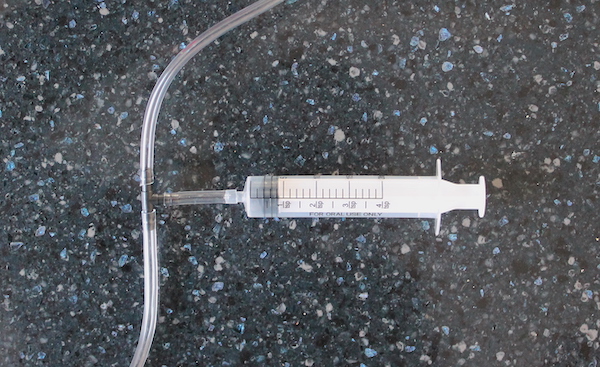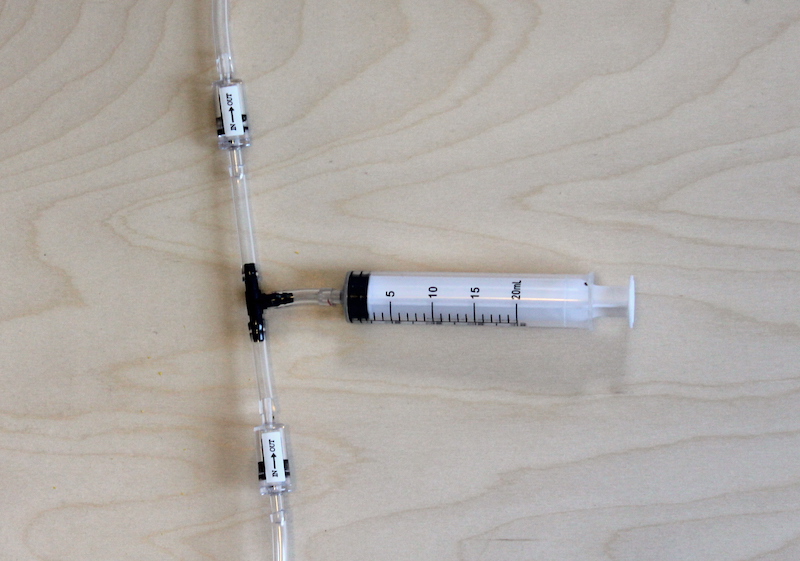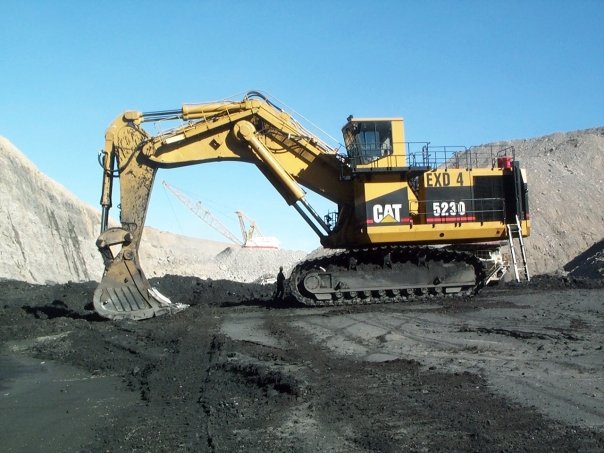A Piston Pump
Experiments with a syringe, using supplies from the pet store.
Most “simple machines” involve solid objects pushing or pulling on each other. A lever rests against a fulcrum, a sprocket moves a chain, and so on. But what about air and water? Is it possible to push and pull on air or water? Can you make machines out of a substance that doesn't have any particular shape, and that just slides and flows around whatever you try to push it with? Is it possible to make a “simple machine” out of air or water?
One way to push on air or water would be just to swat at it and try to push against it with oars or paddles or blades or fins or flippers of some kind. Most animals that swim or fly do this. Most boats and airplanes propel themselves this way, too. The only way to move yourself through air or water is to try to push against it as best you can. Fins and blades can also work in reverse. What if we want to capture natural winds or currents of water and make them do work for us? We usually do this with paddles or blades of some kind as well, and we make windmills or water wheels.
But those spinning things with blades aren't really machines. To really work with water or air in a powerful and controlled way, to make them work as part of a machine, you have to capture them in a container so they can't escape, and then push or pull on them with a moving wall. This is the idea behind the piston-in-cylinder, which was invented by the Ancient Greeks. (At least the idea of it was invented by the Ancient Greeks. It isn't clear to me whether they had the ability to manufacture such things with enough precision to make the parts fit perfectly together, as they need to.) And so much working machinery in the modern world depends on this simple concept. Water pumps, internal combustion engines, hydraulic machinery ... they all have pistons sliding back and forth inside cylinders, to make air or water (or similar fluids) carry force from one place to another.
A Toy Piston
You can experiment with a toy version of this fundamental machine part, with a cheap and readily available device: a simple plastic syringe.

You may have to hunt a little bit, but you should be able to find a syringe or several at a local store without too much trouble. You can frequently find them in the kitchen supply aisle of your local grocery store. Sometimes they are used for dispensing medicine to infants or pets, so you can also try looking for a “dosing syringe” in the drug store. You might also try the hardware store near the paints, adhesives, or lubricants. And you can always order them online from Amazon, or directly from a scientific supply company. If you have a choice among sizes, bigger is generally better. The bigger the syringe, the more air or water it can move, and the more force it can generate.
A syringe like this represents, in a simple hand-held form, the essential element in most of our pumps and engines. They all have at their heart a hollow cylinder, with a second very close-fitting solid cylinder or disk (the “piston”) that can slide back and forth inside the hollow cylinder, while still providing a seal around the edges that prevents water or air inside from slipping past the edges.
Pushing and Pulling
What happens if you just push and pull the piston back and forth inside the syringe? You may notice it “breathing,” as air comes in and goes out through the nozzle. Maybe if you point the nozzle at a candle and push fast enough, you can even blow out the candle.
What happens if you fill the syringe about halfway full with air, hold your thumb over the opening, and then try to push or pull on the piston while keeping your thumb firmly over the nozzle? What happens if you push all of the air out of the syringe, then hold your thumb over the opening, and try to pull the piston back? What happens if you push all the air out of the syringe, then place the nozzle underwater, and try to pull the piston back? What happens if you fill the syringe half-full of water, then put your thumb over the opening, and try to push or pull?
Valves, and Moving Water Around
You have probably noticed by now, if you've been playing with your syringe for a while, that you can fill a syringe from a puddle or a glass of water over here, and squirt it out again over there. You can move water around using your simple syringe, a little like scooping it up and carrying it around in a bucket. But if you really want to move a lot of water around, this way doesn't work very well. Could we make a machine that stays in one place, and just pump the piston in and out and in and out, over and over again, and have it move the water all by itself? Could we make a water-lifter, and raise water from a lower place to a higher place? (This was a common problem in early agriculture. How can you irrigate your fields with water from a river, when your fields are usually higher than your river? And being able to raise water from low places to high places is still a very, very important job to this day.)
What if we connected the nozzle of our syringe to two tubes, and we made one tube go to the place where the water comes from, and the other tube go to the place where we want the water to end up? We'll pull the syringe back, and it will fill up with water from the source, and we'll push the syringe in, and squirt the water to the destination, and so on and so on? Do you see any problems with this idea?

You can buy plastic tubing and a “T” connector in the pet store, with the aquarium supplies. However, if you try to make a pump like this, you'll probably discover that you can lift water from the lower place into your syringe, but when you push the piston back in, the water doesn't go up where we want it to go, it goes back down to where it started. What we need is a way to allow water to come up, but stop it from going back down. We could put valves in the tubes, like doorways, and then open and close the doors at the right time. But that's a lot of work. We'd have to open the lower valve, pull back the syringe, close the lower valve and open the upper valve, and push the syringe in to squirt the water to the high place. Then we'd have to close the upper valve, open the lower valve, and start all over again. What a mess!
But what if we could make a valve that can open and close itself? Think of a door for a minute, a normal swinging door that opens in to a room. What happens if you lean on the outside of the door? It will swing open, and you will fall into the room. What happens if you lean on the inside of the door? It will swing shut, and you will be stuck in the room. Now think about putting doors like that inside our tubes. A simple flap of fabric over a hole might be good enough. If the water pushes on one side, it will push the door open, and flow through the doorway. If the water pushes on the other side, it will push the door closed, and block itself from going any farther. It will be a one-way valve or check valve, one that works all by itself. (Such one-way valves were also invented by the Ancient Greeks.)
Now, what about our toy pump? Do we have to make our own valves? I suppose you could try, but there's a much easier solution. In the pet store, right next to the tubing and the “T” connectors, you can buy cheap “check valves.” They are often make of clear plastic, so you can look inside and see how they work. If we replace our “normal” valves with these “check valves” (and make sure they are pointing the right way!) then all we have to do will be to push and pull on the syringe, and everything else will happen automatically. We will have made our very own homemade piston pump, and we can use it to pump water from wherever we want to wherever we want.

Have you ever used a squirt gun to have a water fight with your brother or sister? How do you suppose the squirt gun works? (If you have an electronic, motorized water cannon or water blaster, it will be more complicated than a simple hand-powered water pistol, but it will still have a pump inside. It's just an electric pump, instead of a hand-powered one.)
Moving Air Around
It is often more difficult to make things air-tight than to make them water-tight. But most of the supplies we used to make our pump were designed to pump air around inside aquariums. Could we use our syringe pump to move air as well as water? Could we connect the outlet to a balloon and use our pump to inflate a balloon? Could we reverse the connections and pump the air OUT of something? Could we make a vacuum pump?
You may be familiar with many hand-held air pumps in the modern world. You might have one in your garage or your recess yard for inflating basketballs and bicycle tires. Sometimes party-supply stores sell “balloon pumps” right next to the balloons. Maybe you (or your parents) have a small hand-pump for pumping the air out of wine bottles. And of course there are the aquarium air-pumps right next to the tubing and the check-valves, for pumping air around in an aquarium. How do all of these air pumps work? Sometimes people make them with clear plastic walls so you can see what's inside. Maybe you can find a very cheap air pump at a thrift store and cut it open. If you look inside one of those, you'll see they are all piston pumps. They all have a piston, and if you hunt, you should be able to find two one-way valves.
(Depending on what kind of pump you have, it might be a little more complicated than our syringe-pump. Often, hand-held air pumps work in both directions. Instead of being open at the back end, the cylinder is closed at both ends, so there is air trapped on both sides of the piston. You can move twice as much air this way. In this case, there will probably be four valves, and two of them will be inside the piston itself. And the aquarium air-pumps are obviously motorized instead of hand-powered, but they are usually pretty simple. You might be able to take one apart and find the valves.)
Piston Versus Piston
What happens if you put a syringe on each end of a tube, and make two pistons fight each other? Try filling two syringes each about half-full of water, and then connecting them together. What happens to the other syringe when you push or pull on the other syringe?

If you've studied “simple machines” before, you may remember some of the rules that they follow. One of the great benefits of levers and gears and things like these is that they can make you more powerful. They allow you to move a big weight with a small force. But you don't get something for nothing. You always pay for the greater force with more or less of something else. (Do you know what the “something else” is?) Now, by playing with your toy “hydraulic cylinders,” do you notice any similarities to other “normal” simple machines? Does this new device of water or air follow the same rules as the others? Have we invented a new kind of “simple machine”?
By the way, if you study construction equipment, excavators, front-end loaders, garbage trucks, or any kind of heavy equipment with heavy moving parts, can you find the “muscles” that make the parts move? Can you guess how those “muscles” work?
